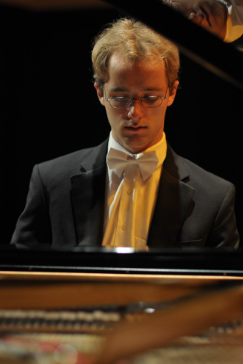Fryderyk Chopin Society of Texas presents Konrad Binienda in Review
Winners of the 25th (2017) International Chopin Piano Competition
Konrad Binienda, piano
Weill Recital Hall at Carnegie Hall. New York, NY
September 17, 2018
The Fryderyk Chopin Society of Texas, based in Corpus Christi, serves as a valuable reminder that not all the piano action in that state is at the Cliburn competition in Fort Worth. The September 17th jumbo double-recital was so generous that two reviewers from this publication were assigned, one to each principal pianist. I will write about Konrad Binienda -my colleague Rorianne Schrade will write about Dzmitry Ulasiuk. Plus, there was an “appetizer” of sorts, the young Jan Godek, who, at the outset, played two mazurkas by contemporary Polish composer Wojciech Klar.
Mr. Binienda has the qualities I value in a pianist: a beautiful sound, a thoughtful approach (meaning every note, phrase, and movement are thought through) which also has plenty of room for feeling, original interpretive ideas, good rhythm, a personal, poetic lyrical sense, and what I like to call emotion “in the tone” itself. He is willing to take risks when the emotional heat rises, sometimes resulting in a performance which is (thank goodness!) not note-perfect, but always convincing, and very moving. His rubato, that “secret” of the early romantics, is perfection itself.
Mr. Binienda began with two preludes by the Akron (OH) pianist/composer, Pat Pace (1931-2006). He went to Juilliard on a full scholarship, but gravitated to the world of jazz and big band. His personal life was full of drama and misfortune, but he recovered and lived a long productive life. The two preludes (Improvisations and Samba) were rendered with beautiful tone and sensitivity to the idiom.
Mr. Binienda then followed with Beethoven’s Sonata No. 17 in D Minor, Op. 31, No. 2, nicknamed “Tempest.” This was a romanticist’s Beethoven, not a classicist’s, but full of feeling. It led to my only negative observation about Mr. Binienda’s entire evening: the third movement, Allegretto, was too fast for my taste, leading to a panicked affect. When reined in just a bit, it gains an obsessive quality that can be equally convincing.
Mr. Binienda then played one of his specialties, Chopin’s rarely performed “concerto without orchestra,” the Allegro de Concert, Op. 46, a genre in vogue in the nineteenth century—Schumann and Alkan also contributed mighty examples. After all, logistically for the performer, it is a lot easier to secure just one instrument, the piano, than an entire orchestra. The main challenge is to differentiate between the massed sounds of the parts imitating an orchestra, and the glittery, more conventional solo-piano passages, and then to be able to combine the two. Mr. Binienda rose to these challenges. When necessary, Mr. Binienda gave the illusion of a full orchestra, yet his filigree work in the difficult piano solo sections was full of charm and the requisite fleet virtuosity, always transparent, with great natural breathing. Mr. Binienda has, I believe, written a thesis on orchestrating the work, though I think that would be a shame (it has been attempted by a few others). It’s supposed to be the piano all by itself, although a comment by Schumann and a letter from Chopin to his publisher in 1841 (the year of the Allegro) have led many to think that it might have been the first movement of a projected third piano concerto.
Mr. Binienda followed that with Chopin’s Sonata No. 3 in B Minor, Op. 58, the first movement of which held together very well. It is often tempting to succumb to “local charms” and make it too fussy, but he did not. In fact, I dare say Konrad Binienda speaks the language of Chopin’s music without any foreign accent—what a pleasure to hear. The middle section of the gossamer scherzo was breathtaking in its poignancy. Mr. Binienda has a way with the little “farewell” moments near the end of movements (not even codas really), and the third movement showed that gorgeously. The finale was properly played presto non tanto, as indicated, and gained in majesty and power from it. Cortot used to say contemptuously that that movement was “the parade ground of the virtuoso,” but how proud he would have been of Mr. Binienda, whose combination of technical ability and poetic sensitivity is ideal.
He favored the enthusiastic (actually sold-out) crowd with an “orchestral” reading of Chopin’s famous A-flat Polonaise, Op. 53, which in his hands regained its heroic national feeling (and also had killer octaves!).

